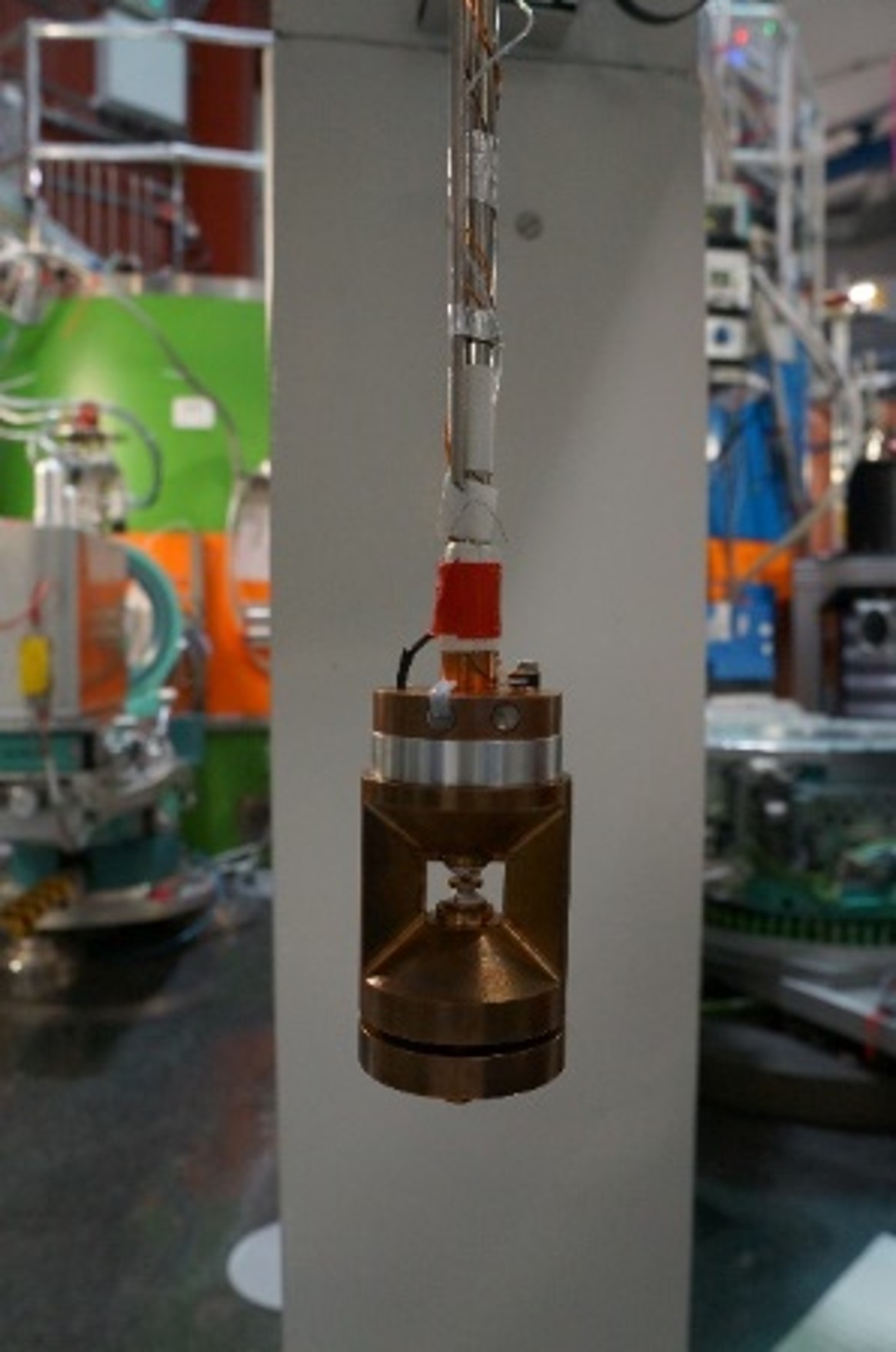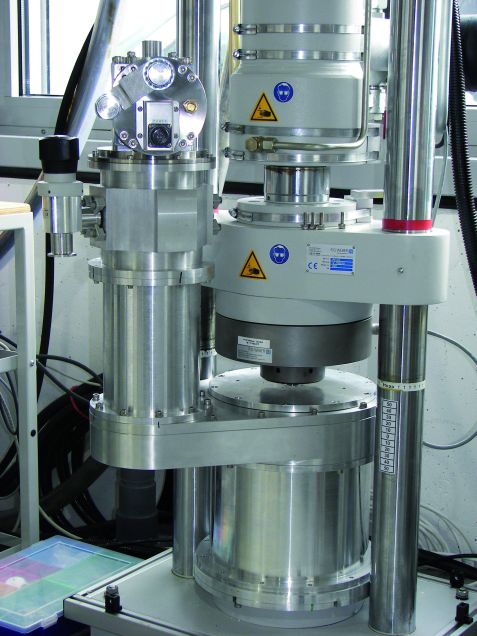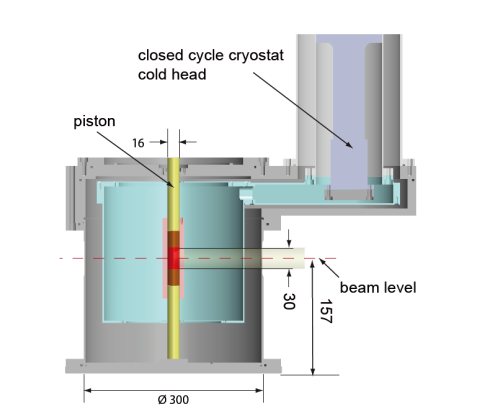MLZ is a cooperation between:
 > Technische Universität München
> Technische Universität München > Helmholtz-Zentrum Hereon
> Helmholtz-Zentrum Hereon
 > Forschungszentrum Jülich
> Forschungszentrum Jülich
MLZ is a member of:
 > LENS
> LENS > ERF-AISBL
> ERF-AISBL
MLZ on social media:

MLZ (eng)
Lichtenbergstr.1
85748 Garching
High Pressure
HP 400 kN press
Specifications
- compressive force: 450 kN
- repulsive force: 220 kN
- dynamic pressure up to 10 Hz possible
Cryostat CC-11-P to be used with HP 400 kN press
Specifications
- Temperature range: 20 K – 600 K
- Cool-down time RT – 20 K: 4 h
- Diameter of sample space: max. 16 mm
- Total height of sample space: 10 mm
- Pressure range: 200 MPa for Ø 16 mm anvil
A special challenge is to go to low temperatures at high pressures. The newly constructed high-pressure cryostat allows one to apply and vary the force in situ, even at low temperature. The sample cell is operated externally by the hydraulic HP 400 kN press. It can be mounted in a dewar and cooled down to below 10 K within four hours. With a piston-in-cylinder cell and a piston diameter of 16 mm a maximum pressure of 2.0 GPa (20 kbar) can be achieved at a sample size up to 30 mm length and 16 mm diameter. Reducing the piston diameter and the sample volume the pressure can be increased up to 100 kbar. Using anvil cells the pressure range extends to 30 GPa (300 kbar) and above. In addition, a dynamic pressure can be superimposed on the static pressure with a frequency of up to 10 Hz.
HPG – 10 kbar
To load gas pressure cells the MLZ provides a gas compression unit for inert gas pressure up to 10 kbar. The unit can be operated either manually or remote controlled. The remote controlled operation allows for individually programmable pressure time profiles. The measurement system includes a high-precision manometer and a pressure transmitter that cover the range up to 10 kbar.
Specifications
Pressure range 105 Pa ≤ p ≤ 109 Pa
Pressure measurement:- 105 Pa ≤ p ≤ 7 · 108 Pa Heise high-precision
manometer; resolution 0.1 % ME - 7 · 108 Pa ≤ p ≤ 109 Pa transmitter; resolution 9 · 106 Pa
Clamp cells for neutron scattering at pressures up to 1.2 GPa
The cells are loaded in a hydraulic press and then clamped by locking nuts. They allow to study samples as single crystals, powders, or liquids. The body of the cells is made of the CuBe alloy. The pressure transmitting medium could be fluorinert or deuterated alcohols. The sample capsules are made of the AlMg5 alloy, teflon, or lead. The pressure inside the cells is determined using the internal NaCl standard (Cell M1) and/or ruby luminescence through the diamond optical window in one of the locking nuts (Cell M2). The cells fit into various cryostats at MLZ.
Diamond anvil cells for neutron scattering up to about 10 GPa
The cells could be operated in the panoramic or transmission modes. In the first case, the incident and scattered beams pass through a gasket that is usually soft CuBe. In the latter one, both beams pass through diamonds. The transmission cells could be used for combined high-pressure neutron and X-ray diffraction studies. All the cells are made of the CuBe or NiCrAl alloys. The pressure transmitting media are deuterated alcohols. The highest pressure depends on the sample volume that is not larger than 0.1 mm3. For this reason, only studies on very strongly scattering samples with high symmetry are feasible. The panoramic cells fit into the cryostats on the beamlines HEiDi and POLI. They are also compatible with the magnets at POLI. Currently, the transmission cells are operated at room temperature.

Panoramic cells
● Two horizontal openings up to 150°
● Vertical openings 80°
● 30-50 mm in diameter, <75 mm in height

Transmission cells
● Opening angle 80°
● 44 mm in diameter, 25 mm in height
● Optional remote pressure change using a He gas membrane (49 mm in diameter, 33 mm in height)
The feasibility of the planned research must be discussed with staff prior to submitting a proposal to MLZ. All clamp and diamond anvil cells are then available on request made in advance to allow for a sufficient time to prepare them for experiments.
Contact
Andreas Buchner
Phone: +49 (0)89 289-14919
E-mail: andreas.buchner@frm2.tum.de
Daniel Vujevic
Phone: +49 (0)89 158860-774
E-mail: d.vujevic@fz-juelich.de
Dr. Andrzej Grzechnik
Phone: +49 2461/61-1234
E-Mail: a.grzechnik@fz-juelich.de
Gallery: Clamp cells for neutron scattering at pressures up to 1.2 GPa





MLZ is a cooperation between:
 > Technische Universität München
> Technische Universität München > Helmholtz-Zentrum Hereon
> Helmholtz-Zentrum Hereon
 > Forschungszentrum Jülich
> Forschungszentrum Jülich
MLZ is a member of:
 > LENS
> LENS > ERF-AISBL
> ERF-AISBL
MLZ on social media:





